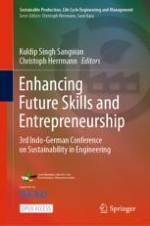3.1 Introduction
3.2 Selection of the Case Company
3.3 Preparation and Analysis of Current Value Stream Map
-
The processing time is approximately 13 days (18702.07 min), while the waiting time is about 24.84 days. Apart from this, a large amount of inventory is piled up before drying, kiln sorting, cutting & grinding, assembly, and final inspection processes/workstations.
-
The inventory of 90 days locked at incoming material stores for the fear of unavailability of raw material.
-
There is a large work-in-process (WIP) before major processes/workstations due to fear of unavailability of right quantity of finished goods. This also causes excess waiting time (24.84 days) and results in higher lead time.
3.4 Actions, Results and Discussion
-
The machine operators were trained to be multi-skilled with objective to start autonomous maintenance by the operators rather than the maintenance staff. It was started in three sections, cutting and grinding, shaping, and testing section.
-
The importance of human resources in the lean implementation is very crucial. Shop floor supervisors were extensively trained to identify bottlenecks and take corrective actions to reduce the scrap and rework.
-
Regular seminars and workshops were organized by external experts to improve communication among employees.
3.4.1 Processing Time
3.4.2 Waiting Time and Work-in-Process Reduction
-
After PED, the pugs were kept in the pug yard for some time with covering of polythene. This step was removed and pugs were directly transferred to the dryer after shaping (waiting time reduced by 0.67 days, WIP to zero).
-
Single piece flow was created among workstations 8-9-10-11 by scheduled leveling. The processing time of dry-finishing (workstation 8) was 206 s and for other three stations it was low (varying between 102 and 106 s). One more station of dry-finishing was installed to make one piece flow. No new worker was assigned at new workstation 8, but two persons who were working for batch shifting in previous layout were used to do the processing at new dry-finishing workstation. This helped in better handling of material, reduction in motion time, reduction in waiting time and drastic reduction in floor inventory (WIP reduced, waiting time reduced, handling defects reduced).
-
The kiln department was facing shortage of space. Efforts were made to reduce the inventory on the shop floor. It was observed that inventory was high in the post-kiln operations. Previously XXX was holding 7 days inventory in the warehouse because of poor communication and just-in-case tendency. Electronic information flow was started for the suppliers, which reduced the inventory to 6 days. It also helped in reducing order quantity and inventory at raw material stores in the company. Inventory level of raw material in store reduced to 2 months from 4 months. Inventory was reduced in pre and post kiln operations (Reduction in WIP along with reduction in WT after workstations 16, 18 and 21). Overall WIP is reduced by 36% starting from ball milling to packaging.
3.4.3 Space Creation
3.4.4 Breakdown Reduction
S. No. | Name of workstation | Monthly average breakdown before autonomous maintenance (h) | Monthly average breakdown maintenance (h) |
|---|---|---|---|
1 | Shaping | 6.14 | 3.52 |
2 | C&G | 7.60 | 3.90 |
3 | Testing | 8.88 | 3.88 |
3.4.5 Defect Reduction
3.4.6 Kiln Rejection
3.4.7 Post Kiln Rejections
3.4.8 Material Handling Rejection
3.4.9 Manpower Reduction
3.5 Conclusions
-
Waiting time reduction by 32%
-
Processing time reduction by 191.56 min. (1.02%)
-
Reduction in inventory/WIP by 36%
-
Defects reduction (average) by 40.51%
-
Space creation for further use is 719 m2
-
Reduction in manpower by 6.85%
-
Cost saving of US $ 0.61 million in one financial year.
